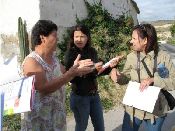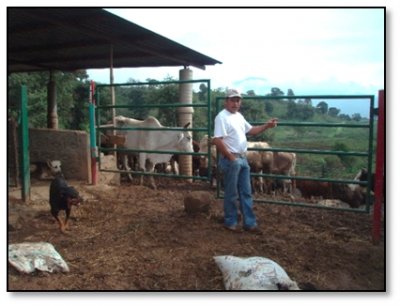| Crop rotation and minimum tillage: experimental results and conclusions |
 |
|
The effect of crop rotation on infiltration, runoff generation and sediment production were tested. The discharge from the Cortina and Potrerillos watershed in 2010 seems to have nearly the same values (4 and 6 m³ s-¹). The discharge from the Huertitas sub-watershed was a little lower than the other two. Since this catchment is 3 times smaller than the other catchments the Heurtitas sub-watershed can be considered more degraded. Infiltration measurements show that it is very high in Andisols as compared to the Acrisols (3 mm/h). Crop rotation seems to have not much effect in infiltration rates. But, it can have differences within the same crop rotation system, for example infiltration on the ridge of the furrows and at the lower parts can be very different. This variation must be taken into count in the modeling and interpretation of runoff and soil erosion.
Rainfall was nearly 50% higher in in 2010 as compared to 2009 which resulted in higher sediment concentration with the highest concentration in the sub-watershed of Poterillos.
The two catchments generated high sediment yields (Huertitas, 900–1500 t km−² y−¹; and Potrerillos, 600–800 t km−² y−¹). The sub-watershed of La Cortina generated a rather low sediment (30 t km−² y−¹). At the scale of the entire Cointzio basin (630 km²), it was not possible to derive any direct relationship between rainfall intensity and sediment concentration. This can be explained by the high spatial variability of rainfall and due to vegetation growth throughout the season. Erodible sediment availability on hill slopes was identified as the main factor controlling suspended sediment delivery. The occurrences of numerous active gullies in Huertitas and Potrerillos provided a constant sediment source linked to the river network, which explains the high SSY recorded at both stations. At the sub-watershed scale, a combination of various parameters was responsible for sediment control. Peak discharges during floods were found to be significantly associated with exported loads; discharge proved to be a controlling factor when sediment was not lacking.
No evaluation results were given so this analysis cannot be done.
The agro-climatic measuring instruments, rain gauges, water level and sediment trap installation were located in the farmer's fields. The farmers took care of the instrument and in some case, they also helped to take samples, and do some measurements. As the farmers were paid, they were interested. But they don't see a direct interest for themselves because our results are interesting at a watershed scale and not really at individual farm level. If the regional authorities want to stop sedimentation of the dam, an integrated policy is needed.
|
|||||||||||||||||||
Study sites

Acknowledgement
The DESIRE project was
|
DESIRE brought together the expertise of
26 international research institutes
and non-governmental organisations.
This website does not necessarily
represent the opinion of the
European Commission. The European
Commission is not responsible for
any use that might be made of the
information contained herein. 






